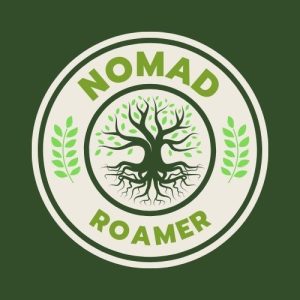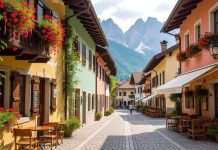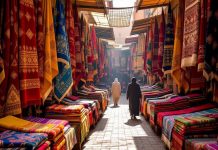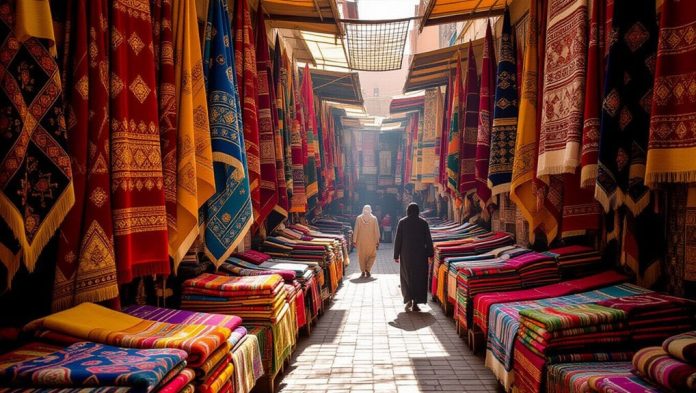Morocco's souks are lively wonders where you can uncover unique textiles, intricate ceramics, and fragrant spices that embody the essence of local culture. Wander through narrow alleys, and keep an eye out for leather goods and traditional metalwork. Don’t forget to engage with the vendors over a cup of mint tea—it can lead to delightful discounts. Immerse yourself in the spirited atmosphere, and you might just reveal hidden treasures waiting to be claimed. Investigate further to uncover more enchanting secrets.
Key Takeaways
- Explore early mornings in souks for better prices and fewer crowds while discovering hidden treasures off the main paths.
- Engage with local vendors to learn about their crafts, enhancing your understanding of Moroccan culture and artistry.
- Embrace the tradition of sharing mint tea, fostering goodwill and improving your negotiation outcomes.
- Look for unique goods like spices, ceramics, and textiles that reflect Morocco's rich history and craftsmanship.
- Time your visits around local festivals for significant discounts, allowing you to unearth ancient treasures at lower prices.
Essential Souk Finds and Their Fair Prices
Wandering through Morocco's lively souks, you'll encounter a treasure trove of unique finds that embody the essence of the culture. Among the colorful stalls, spices beckon with their vibrant displays, priced around $2 to $5 per 100 grams—perfect for bringing a taste of Morocco back home.
As you investigate further, you’ll spot exquisite ceramics, with small bowls costing $10 to $15 and larger tagines ranging from $50 to $80, each piece telling a story of tradition.
Don't miss the enchanting metalwork; hand-hammered teapots can be yours for $150 to $300, while brass lanterns typically range from $200 to $500.
Finally, indulge in the local leather goods, where authentic artistry shines. Prices for traditional babouches start at 150 dirham, and high-quality leather bags range from 400 to 800 dirham. Each find is a piece of Moroccan craftsmanship waiting for you to take home!
Leather Goods
As you investigate the lively souks of Marrakech, don’t overlook the enchanting world of leather goods that showcase the city’s rich artisanal heritage.
The colorful stalls brim with handmade items, from the iconic babouches—traditional Moroccan slippers priced between 150 and 250 dirham—to exquisite leather bags that can range from 400 to 800 dirham.
For authentic artistry, make sure to visit the Chouara Tannery, where skilled artisans create stunning pieces using age-old techniques.
When you’re ready to shop, remember that haggling is part of the experience; start your negotiations at about 30% of the seller’s initial asking price.
Always inspect the leather for quality—high-quality items should feel soft and supple, free from cracks or defects.
Immerse yourself in the colorful atmosphere of the Souks of Marrakech, and you’ll find treasures that reflect the essence of traditional Moroccan artistry.
Textiles

The lively world of textiles in Marrakech beckons with its rich colors and intricate designs, each piece an indication of the city’s storied artistry.
Immerse yourself in Marrakech's vibrant textile scene, where every piece reflects the city's rich artistry and tradition.
As you wander through the bustling souks, let the vibrant threads and patterns captivate your senses. Here, you’ll find unique souvenirs that tell a story of tradition and artistry:
-
Hand-woven Berber rugs adorned with tribal symbols
-
Colorful traditional blankets bursting with Moroccan spirit
-
Soft cotton djellabas that blend comfort and local style
-
A chance to connect with artisans who pour their heart into every stitch
Prices vary, with hand-woven rugs starting at 500 dirham and traditional blankets around 300 dirham.
Don’t forget to negotiate prices, as bargaining is part of the experience—often starting at 30% of the initial asking price.
Embrace the thrill of uncovering the perfect textile treasure in this enchanting market!
Metalwork & Lamps
Stepping into the markets of Marrakech, you'll be enchanted by the shimmering array of handcrafted metal creations that adorn the stalls. Among the treasures, you’ll discover stunning brass lanterns, intricately designed and priced between 200 to 500 dirhams. Each piece is a unique representation of Morocco's rich cultural heritage.
Don’t miss the hand-hammered teapots, a favorite among visitors, typically ranging from 150 to 300 dirhams.
As you navigate through the lively souks, remember to inspect each metalwork piece carefully for quality and authenticity. Look for intricate patterns and check for any cracks or imperfections.
To snag the best deal, don’t hesitate to ask for the “best price for cash”—vendors often appreciate cash transactions and may offer you a discount. Embrace the art of negotiation and take home a beautiful piece of Moroccan artistry, a reminder of your enchanting journey.
Argan Oil & Spices

After admiring the exquisite metalwork, your senses will be captivated by the rich aromas wafting through the souks, drawing you toward the lively displays of argan oil and spices.
Here, you’ll find yourself surrounded by a dynamic mosaic of local culture, with vendors enthusiastic to share their knowledge.
-
Argan oil, often touted for its beauty benefits, may cost you around $10-$15 for 100ml, but beware of fakes.
-
Spices, ranging from $2-$5 per 100g, burst with flavor, with ras el hanout being a must-try.
-
Engaging with merchants can reveal fascinating stories about the origins of these products.
-
Sampling spices before buying enriches your experience and connects you to the local community.
As you traverse, each scent and taste deepens your appreciation for Morocco's culinary treasures, making your journey through the souks truly unforgettable.
Ceramics & Tagines
As you wander through Morocco's lively souks, the stunning ceramics and tagines catch your eye with their unique hand-painted designs.
Each piece tells a story of local culture, showcasing intricate patterns that reflect the artistry of Moroccan artistry.
Before making a purchase, be certain to check for cracks to guarantee you’re taking home a quality treasure that connects you to this rich heritage.
Unique Hand-Painted Designs
In Morocco, you'll discover a stunning array of hand-painted ceramics that burst with color and intricate designs, each piece a tribute to the country's artistic heritage.
These unique hand-painted designs reflect the lively culture and artistry of Moroccan artisans. From large tagines to small bowls, every item tells a story.
-
Rich, lively colors that captivate the eye
-
Intricate patterns inspired by centuries of tradition
-
Functional pieces that double as stunning decor
-
Affordable treasures, perfect for souvenirs
As you navigate the souks, you’ll find that each ceramic piece serves both a practical purpose and an artistic one, adding a distinctive Moroccan touch to any home.
Don't miss the chance to bring a piece of this enchanting heritage home with you!
Quality and Authenticity Tips
When you’re exploring the lively souks of Morocco, knowing how to assess the quality and authenticity of ceramics and tagines can elevate your shopping experience.
Start by inspecting items for cracks and imperfections—these flaws can impact both quality and durability. Look for vivid colors and intricate patterns, as they’re hallmarks of high-quality Moroccan pottery. Each hand-painted piece tells a story, reflecting the rich culture of the artisans.
When shopping, ask about the artisan or workshop that created your chosen items; this not only verifies authenticity but also boosts their cultural value.
Expect to pay around $10 to $15 for small bowls and $50 to $80 for larger tagines, allowing you to find treasures within your budget.
A Successful Souk Shopping Experience

When you step into the lively souks of Morocco, you're not just shopping; you're immersing yourself in a rich mosaic of culture and artistry.
To snag the best deals, remember that bargaining is a spirited dance, and building rapport over a cup of mint tea can truly improve your experience.
Plus, visiting early in the morning and paying with cash often opens up even better prices, making your souk adventure both rewarding and memorable.
Cultural Immersion Benefits
Stepping into the lively souks of Morocco, you'll find that shopping transcends mere transactions; it’s an immersive cultural experience. Engaging with local artisans offers you rich cultural insights and a glimpse into their unique artistry, enriching your journey.
As you navigate the bustling alleys, you’ll discover:
-
Heartfelt stories shared by artisans about their trade
-
The warm tradition of mint tea, showcasing Moroccan hospitality
-
Each purchase as a cultural souvenir that supports local livelihoods
-
A lively atmosphere filled with local flavors and artistry
This deep connection allows you to appreciate the history behind traditional Moroccan products, making your souk shopping not just a hunt for treasures, but a memorable encounter with the essence of Moroccan culture.
Effective Negotiation Strategies
How can you navigate the lively world of Moroccan souks without getting lost in the art of negotiation? To master effective negotiation strategies, start low—about 30% of the seller's initial asking price. Build rapport through friendly conversation, and don’t hesitate to ask for the “best price for cash.” Patience is your ally; showing you might walk away often leads sellers to reconsider. Sharing mint tea promotes goodwill and can lead to better deals.
| Strategy | Description |
|---|---|
| Start Low | Begin negotiations at 30% of asking price. |
| Build Rapport | Engage in friendly conversation. |
| Ask for Cash Discounts | Request the “best price for cash.” |
| Be Patient | Show willingness to walk away. |
| Share Mint Tea | cultivate goodwill through this tradition. |
Navigating the Souks: Shopping Tips & Surprising Insights
While diving into the lively maze of Morocco's souks, you'll uncover a treasure trove of unique goods and local artistry that beckons to be investigated.
To improve your shopping experience and unearth hidden gems, keep these tips in mind:
-
Visit early (8-10 AM) for better prices and fewer crowds.
-
Venture off the main paths for competitive rates and local artistry.
-
Time your visit around local festivals for discounts up to 70%.
-
Engage in the tradition of sharing mint tea with vendors to encourage friendly negotiations.
Frequently Asked Questions
Which Souk Is Best to Visit in Marrakech?
When you’re in Marrakech, don’t miss Souk Semmarine for the best shopping experiences. It’s the main artery of the souks, bursting with colorful textiles, pottery, and leather products.
You’ll find unique artisan creations that reflect the region's rich heritage. For a sensory delight, head to Souk El Attarine, where aromatic spices and perfumes await.
Each souk offers a distinct charm, but Semmarine is your go-to for a well-rounded taste of Marrakech’s treasures.
What's the Difference Between a Souk and a Medina?
Think of a souk as a lively mosaic woven from the threads of commerce, while a medina serves as the sturdy loom that holds it all together.
Souks are bustling markets where you haggle for spices and handiwork, showcasing local artisans. In contrast, the medina's architecture carries deep cultural significance, with narrow alleys and historic sites reflecting a rich heritage.
Together, they create an energetic interplay between trade and tradition, defining Moroccan life.
What Are Souks in Morocco?
Souks in Morocco are lively marketplaces bursting with life, showcasing the country's cultural significance through traditional artistry.
As you wander through these maze-like alleys, you'll encounter artisans selling textiles, spices, and unique handmade goods. Engaging with local traders, you’ll quickly learn bargaining techniques to negotiate prices, often starting at about 30% lower than the initial ask.
These bustling souks not only provide a shopping experience but also a glimpse into Morocco's rich heritage and artistry.
What Makes Souks Different From Other Markets?
Souks stand out from other markets due to their rich cultural significance, lively atmosphere, and a focus on unique products created by local artisans.
As you wander through the maze-like alleys, you'll discover treasures that tell stories of Morocco's heritage.
Here, haggling techniques are crucial; it’s not just about the price, but building relationships with vendors.
The sensory experience—filled with sights, sounds, and scents—makes shopping in souks an unforgettable adventure.
Conclusion
As you wander through the lively souks, each turn reveals a new treasure waiting to be discovered. The scent of spices lingers in the air, while handcrafted leather goods beckon you closer. But beware—bargaining isn’t just a skill; it’s an art that can lead to unexpected surprises. Will you uncover the perfect piece to take home, or will the maze of stalls keep its secrets hidden? The adventure is yours to embrace, and the treasures are waiting.




























